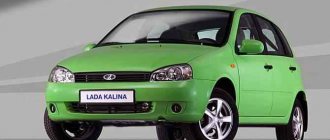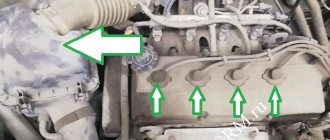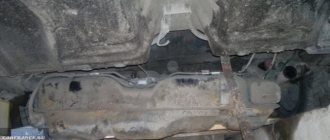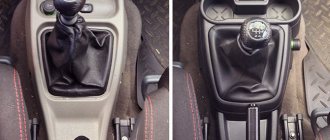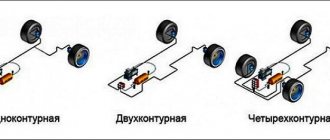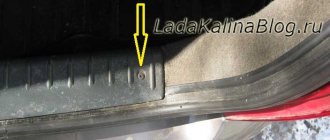This is the Lada model
The Lada Kalina station wagon (factory code VAZ 1117) appeared on the country's roads in early 2007. This car was developed on the basis of the VAZ 1118 sedan, which entered the market 3 years earlier. Like all cars of this model range, Kalina 1117 was created for intensive driving in urban conditions and, depending on the configuration, was equipped with 2 different injection engines, which provided the car with excellent dynamics. Despite similar speed and technical characteristics, the station wagon had a number of advantages compared to a hatchback car. Firstly, it was 19 centimeters longer, which significantly improved the comfort of rear seat passengers and increased the volume of cargo carried. Secondly, the station wagon’s ground clearance is 2.5 cm higher, which ensures better cross-country ability on snowy and dirt roads.
During the production process, the machine was constantly modernized. In 2010, buyers were surprised by the new interior design. In 2011, the car began to comply with EURO 4 environmental standards and received an electronic gas pedal. But despite constant updates, in the spring of 2013 the 1st generation station wagon was discontinued.
Vehicle configuration
Inside the car
The Lada Kalina family was created on the VAZ 2108 platform. The progenitor of the new model received a significantly redesigned chassis, as well as the layout of the power unit and transmission. The angular shapes completely disappeared from the exterior; in general, it could be called modern and inviting. All hard plastic parts have been removed from the interior. The panels became soft and warm, this was especially noticeable in cars produced in 2010-2013. In general, a description of all the changes that the mother platform has undergone can take several pages, so let’s note the main thing: the car has become many times more convenient and safer than the Lada Samara.
From the very beginning of production, the station wagon was offered in 2 trim levels:
- "norm";
- "luxury".
The first configuration had the following set of free options.
- Adjustable steering column.
- Central locking.
- Power windows for front doors.
- On-board computer.
- 14-inch wheels.
- Electric power steering (only in package 11173-140-40).
The luxury version, in addition to everything described above, was additionally equipped with air conditioning and an anti-lock braking system (ABS).
Presentation of the car at the factory
The cost of the top version without ABS in 2013 was 360,000 rubles. For an additional fee, it was possible to install front airbags, foglights and heated front seats. The price of such a package of options was from 25,000 rubles.
Since 2007, the Lada Kalina has been equipped with 2 naturally aspirated gasoline engines:
- VAZ 21114 - 1.6-liter, 8-valve, 81 horsepower;
- VAZ 11194 - 1.4-liter, 16-valve, 89 horsepower.
Depending on the model of the power unit, the station wagon was designated as Kalina 11173 or Kalina 11174. It is important to note that the 8-valve engine was installed only on cars in the “norm” configuration. The 16-valve engine was mainly installed on cars of the “luxury” configuration, but for an additional fee it could also be installed on the Kalina “norm”.
Advantages and disadvantages of a station wagon
According to the manufacturer, the Lada Kalina 111730 is the most widely used. The technical features of this modification of the car best meet the “price-quality” criterion.
Customer reviews indicate that the station wagon has both pros and cons.
New model Cross 2014
Advantages of a car.
- Low cost.
- Spacious interior.
- Excellent visibility.
- Good cross-country ability on rural and snowy roads.
Negative features of the model.
- Noisy gearbox (gearbox).
- Modification 11173 has a noisy interior.
- Flimsy glass washer hose for door 5.
- Unreliable connecting rod and piston group (CPG) on modification 11174.
Technical characteristics and dimensions of Lada Kalina 111730:
- length - 4040 mm;
- width - 1700 mm;
- height - 1500 mm;
- ground clearance - 185 mm;
- base - 2470 mm;
- front track - 1430 mm;
- rear track - 1410 mm;
- trunk volume - 350 liters (650 with the rear seat folded);
- curb weight - 1080 kg;
- maximum weight - 1555 kg;
- wheel formula - 4x2;
- drive - front;
- engine - gasoline, naturally aspirated, 4-stroke;
- volume - 1.6 liters;
- number of cylinders - 4;
- number of valves - 8;
- maximum power - 81 hp. With.;
- maximum torque - 120 Nm;
- recommended fuel grade - AI 95;
- average fuel consumption per 100 km - 7.8 l;
- gas tank volume - 50 l;
- maximum speed on the stand - 160 km/h;
- Gearbox - manual, 5-speed;
- final drive ratio - 3.7;
- recommended tire size - 175/65 R14, 185/60 R14.
Lada Kalina is a fairly liquid car. You will not lose money when selling it on the secondary market. Young people love this car very much. In addition, tuning a car is a real pleasure.
The lineup
To be honest, the second generation Kalina is not a completely new model. This is nothing more than the result of a deep restyling of the first generation car, which debuted in 2004. Many changes were made to the design, which also affected the reliability of Kalina 2. The problem of unpredictable breakdowns, due to which many people ignore AvtoVAZ products, was practically solved.
Lada Kalina 2 station wagon
Lada Kalina 2 hatchback
The “second” Kalina model range consisted of a hatchback and a station wagon. Subsequently, on the basis of the latter, an all-terrain version of Cross was created, differing from the original by increased ground clearance and a modified appearance. Kalina Cross is most popular in the secondary market. Kalina is supported by the fact that this model is assembled using modern equipment, thanks to which the notorious human factor during assembly is practically reduced to zero.
Lada Kalina is painted using an automated complex. So you won’t be able to find fault with the quality of the painting. However, on used copies it is better to monitor the condition of the enamel. It is better to touch up deep scratches and chips. Owners of Kalina will not have any major problems with corrosion, but additional anti-corrosion protection will still not hurt a domestic car.
Comparison of different generations of Lada Kalina
The main and most obvious difference is the appearance. After restyling, Kalina received a new massive bumper in a modern design. The optics of the headlights have also changed, which is now complemented by daytime running lights. By the way, when the car was presented at the Moscow Motor Show, the DRLs were LED, but they are no longer available in the production model.
Changes are also visible from the side, and they are mainly caused by the bumpers. If the front one turned out to be massive, then the rear one, on the contrary, is small. The taillights have changed slightly in shape, and now part of them extends more to the side. The changes are also noticeable when looking at the rear headlight unit: they have become much larger and look more interesting than on the first generation station wagon.
Changes in the cabin
The interior has changed significantly after the change of generations. The developers began to use a completely different dashboard and a different instrument panel. There is no trace left of the first generation design. Controls for a modern climate control system have appeared. Depending on the configuration, a multimedia system with a touch screen can be installed. The display is located at the top and is covered with a special visor that prevents glare in bright sunlight. All controls are placed in separate blocks. The side air ducts are Granta style, but the center console uses rectangular vents.
Separately, it is worth mentioning the seats, which have also been updated. Now they have pronounced lateral support, and in top trim levels there is even a lift function, i.e. height adjustment.
Engine range
In total, the second generation Kalina uses three types of engines, all with a lightweight piston group.
- 8-valve engine from Granta. The weakest power unit in the line with a capacity of 87 hp. With. Everyone is familiar with the engine from the VAZ 2108, or rather, its early modification. At the same time, this is the most reliable engine with a service life of at least 200,000 km without major repairs.
- 16-valve engine from Priora. Installed without any significant changes, the power is 98 hp. With. according to your passport.
- New engine with 106 hp. With. The engine is 16-valve and is installed today, including on the Lada Vesta. It is distinguished by the presence of variable injection geometry and some other upgrades.
The previous generation could only boast of a Priora engine, and then only in the maximum configuration.
Transmission
The changes affected her too. Now, in addition to a manual transmission, Kalina began to be equipped with an automated robotic gearbox and even a full-fledged Jatco 4-band automatic transmission. The automatic transmission will be available in the maximum configuration and only with the top-end engine. Many motorists have been waiting for a very long time for a full-fledged automatic to appear on domestic cars. Yes, this is an old 4-speed gearbox, but it is reliable and inexpensive to maintain.
Suspension
AvtoVAZ engineers tried not only to change the appearance of Kalina, but also to make serious adjustments to all important components and assemblies. The changes also affected the chassis. The suspension is completely borrowed from Granta. Specialists from the Nissan-Renault concern made an invaluable contribution to the development and optimization of the unit settings. Compared to the old suspension, the changes are significant. Now the wheels have negative caster (as if the top side is piled inward). The car has become more stable on the road when making sharp turns. Improved handling and overall driving comfort.
Technical characteristics of a used Lada Kalina 2
Steering gear and chassis
The suspension of Kalina, as well as that of the Cross version, copes well with our roads. Frankly, there are no weak points in it. Provided you use high-quality consumables, you will have to remember about it no more than once every 70-80 thousand kilometers. Shock absorbers, ball joints and silent blocks have approximately the same service life. Suspension arms give up later - only after 150 thousand kilometers. Those who want to save money can find frankly cheap and not very high-quality Chinese spare parts, but their replacement interval will also be reduced. As a result, there will still be no significant savings, and you will have to spend more time visiting the service.
The weak point of the used Lada Kalina 2 is the rack and pinion steering mechanism. It can start knocking after 50 thousand kilometers. Most often, tightening the mechanism helps get rid of knocking. If not, then you will have to contact the experts to rebuild it. Fortunately, this procedure for Kalina is not very expensive.
Motor reliability
The base engine for the second generation Kalina is the 87-horsepower eight-valve VAZ-11186. This engine has low-end torque and revs well at high revs. So, despite not the highest power, it can be fully recommended for Kalina. The main thing to remember is that in this engine, when the timing belt breaks, the valves bend. The conclusion suggests itself - it’s not worth waiting until the factory-recommended mileage of 60 thousand, at which time the timing belt needs to be serviced. It is better to protect yourself and do this after the mileage exceeds 50 thousand kilometers.
In addition, owners should definitely monitor the condition of the rollers and water pump. If there is a backlash in the pump, then under no circumstances should you postpone visiting the service. Immediately after starting, the used Kalina 2 engine may make a characteristic clicking sound. Many owners are sure that these sounds are made by hydraulic compensators, but in fact this is a clear hint that the valves require adjustment. If nothing is done, then after 40-50 thousand kilometers the valves will burn out.
The second power unit available for Kalina with the same volume of 1.6 liters develops 98 horsepower. It doesn't make much sense to pay extra for this motor. In terms of dynamics, it is only slightly better than the 87-horsepower power unit. It's another matter if you are looking for a Kalina with an automatic transmission. In this case, there will be no alternative to the 16-valve 98-horsepower engine.
The most powerful Kalinovsky engine with a volume of 1.6 liters develops 106 horsepower. The motor turned out to be very flexible and is excellent even for the relatively heavy Cross version, but the problem with valves bent when the timing belt breaks is also typical for it. If we talk about the general disadvantages of VAZ engines, then they include an unreliable thermostat. Sometimes used engines start to misfire, which can be treated by replacing spark plugs and ignition modules.
Video: Lada Kalina 2 (expert opinion)
Possible problems with electrical and gearbox
The weak point in the electrical system of a used Kalina 2 is the generator. On average, it lasts 3-4 years. Although there is hardly any need to be seriously upset about this. The cost of a new generator and its replacement is low. After a mileage of 75 thousand kilometers, the oxygen sensor will need to be replaced. From time to time you will have to clean the throttle valve, which will help avoid floating speed. If this does not help, you need to replace the idle speed and throttle sensors. Sensors for Kalina are inexpensive.
The most common transmission on Lada Kalina is a 5-speed manual. And if on cars of the first generation it often reminded of itself, then on the “second” Kalina the seriously redesigned mechanism is distinguished by quite high reliability. Thus, the clutch can last 100 thousand kilometers, and the gearbox itself will require repair only after a run of 200 thousand kilometers.
There are no complaints about the Jatco automatic transmission either. With proper operation, it will not remind you of itself before a run of 200-250 thousand kilometers. There is also no need to worry about possible repairs to the machine. Due to the simple design of the box, it will not be so expensive. And they will take it up in any service that deals with similar problems.
The third transmission option is a robotic gearbox, where the clutch automatically closes and opens using servos. And if the “robot” does not work the best on the Vesta model, then on the lighter Lada Kalina there are much fewer complaints about it. Due to the fact that the electronics handle the clutch extremely carefully, its service life on the robotic Kalina is often even higher than on cars with traditional “mechanics”.
For a poor buyer who counts every penny, a second-generation second-generation Lada Kalina can be an excellent car for every day. For the same money, of course, you can buy a Renault Logan, but other things being equal, it will be worse equipped and have a higher mileage. And in terms of reliability, foreign cars do not have a noticeable advantage. As it turned out, Lada Kalina 2 is far from those “semi-finished products” that were produced at AvtoVAZ not so long ago. So you can safely buy domestic “berries”.
